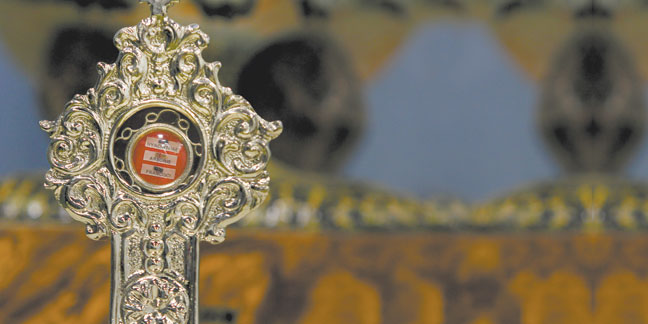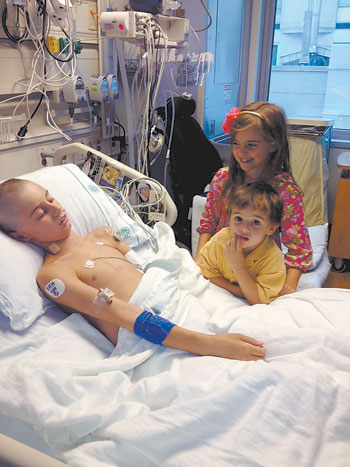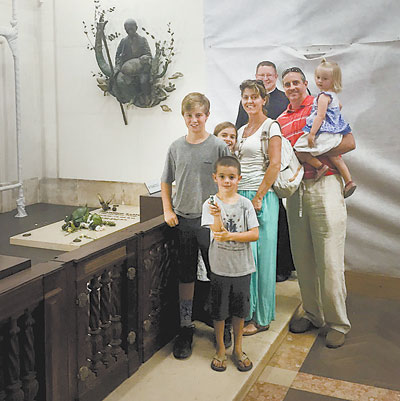 During a sudden life-threatening illness, Charles Kennedy had an army of saints at his bedside.
During a sudden life-threatening illness, Charles Kennedy had an army of saints at his bedside.
Early in the morning of Aug. 9, 2013, the 9-year-old boy suffered a hemorrhagic stroke when a blood vessel burst in his brain. He was rushed by ambulance to Carolinas Medical Center in Charlotte, where he lay in a coma as doctors rushed to treat the problem before the boy suffered permanent brain damage.
His mother, Margaret Kennedy, immediately reached out to St. Patrick Cathedral and its pastor, Father Christopher Roux, a close family friend. He arrived at the hospital quickly and anointed Charles before the boy was taken for a CT scan to investigate the cause and extent of the damage from the stroke. When he returned for a second visit, Father Roux brought a reliquary containing relics of Sts. Jacinta and Francisco, two of the shepherd children Our Lady of Fatima appeared to in 1917. A small fragment of the holm oak tree Our Lady appeared above is also encased in the reliquary.
The relics of the Portuguese saints were placed in Charles’ hand as he lay motionless in his hospital bed. Family and friends rallied to pray to Our Lady of Fatima and to the little saints for his healing. When the pressure on Charles’ brain increased, doctors performed surgery to put a shunt in his brain. The pressure in his head was dangerously high, so Father Roux instructed the Kennedys to move the relics to Charles’ head. Not long afterwards, the pressure on his brain dropped just enough that doctors could perform a critical MRI of his brain. But on the same night the MRI was done, Charles developed pneumonia. Father Roux told the family to move the relics to Charles’ chest and keep praying.
After they had moved the relics to Charles’ chest, X-rays were taken at 2 a.m. to monitor the pneumonia. The X-rays showed the pneumonia had vanished.
 Charles Kennedy, who suffered a hemorrhagic stroke, lies in his hospital bed with the relic of St. Teresa of Calcutta taped to his arm during a visit with his family. “We’ve always had a devotion to the saints,” says Charles’ mother.
Charles Kennedy, who suffered a hemorrhagic stroke, lies in his hospital bed with the relic of St. Teresa of Calcutta taped to his arm during a visit with his family. “We’ve always had a devotion to the saints,” says Charles’ mother.
She recalled Charles receiving his first Holy Communion at the tomb of St. Cecilia in Rome on the feast of our Lady of Fatima, May 13, 2012, when the family was on a pilgrimage to Italy. During the trip they also prayed at the tombs of St. Francis and St. Clare in Assisi, and they traveled to Pollone, where they visited the summer home of Blessed Pier Giorgio Frassati, a young man who lived an exemplary life of holiness. Charles and his family prayed at the bedside where Blessed Pier Giorgio drew his last breath.
When Charles suffered his stroke, Margaret says she “called out to Mary, to Blessed Pier Giorgio, out loud,” asking for their intercession to save the life of her young son.
As Providence would have it, Father Lucas Rossi, another family friend who was assigned to St. Patrick Cathedral at the time, had a second-class relic of Blessed Pier Giorgio. He brought it to the hospital for Charles.
And the army of saints kept marching in.
The Missionaries of Charity in Charlotte also visited Charles in the hospital, bringing a first-class relic of their founder Mother Teresa to ask for her intercession with his healing.
One of Margaret Kennedy’s sisters, Dominican Sister Mary Cecilia, came from her convent in Nashville, Tenn., bearing a relic of St. Cecilia, the patron saint of musicians.
A niece, who lives in the Netherlands, had the local Carmelites of the Divine Heart of Jesus send a first-class relic of Blessed Mother Maria Teresa of Jesus, founder of the Carmel, who died in 1938. Declared venerable by St. John Paul II in 2002 and approved for beatification on May 13, 2005, by Pope Benedict XVI, she is in need of another miracle to be raised to sainthood.
Prayers for Charles were also taken to the Chapel of the Apparitions at the Cova da Iria in Fatima. A religious sister whose order helps care for the Shrine of Our Lady of Fatima and its visitors also took prayer petitions for Charles directly to the tomb of St. Francisco, seeking his intercession.
A statue of St. John Vianney was also brought to Charles’s hospital room and stayed with him throughout his hospitalization. It had been touched to the saint’s tomb by a seminarian who had traveled to France to obtain a statue of
the saint for the cathedral, as a way for parishioners to pray for an increase of priestly vocations in the diocese.
“We were begging them (all the saints) to help him,” Kennedy recalls. “Father Roux told him to talk to Mary (the Blessed Mother), to talk to Francisco because he knows of illness. He said, ‘The little shepherds are here. They will take care of you.’”
Charles lay in a coma for three weeks. He was put on a ventilator and underwent brain surgery. When doctors were finally able to reduce his medication and bring him out of sedation, his mother told Charles that she hoped the Blessed Virgin Mary had been with him.
“Francisco has been keeping me company,” Charles replied.
“Every day we prayed with the relics,” Kennedy recalls. “The whole thing was incredibly miraculous. Charles was healing so quickly. We couldn’t believe it!”
Besides a scar on his head, Charles has a slight paralysis in his left leg that requires him to wear a brace. He cannot participate in some of the athletic activities he once enjoyed, but he enjoys baseball and is able to serve at the altar and play the violin and cello.
 The Kennedy family made a pilgrimage of thanksgiving to Fatima, Portugal, in 2016 to thank Sts. Jacinta and Francisco for their intercession in Charles’ healing. They are pictured with their pastor, Father Christopher Roux of St. Patrick Cathedral, in front of St. Francisco’s tomb in Fatima. “A neurologist told me the week of his stroke that the part of Charles’ brain where the hemorrhage occurred is the musical part of the brain and to prepare for his musical abilities to be affected,” Kennedy recalls. “But his music teacher has been astounded at his ability to play many different instruments so well. Another miracle!”
The Kennedy family made a pilgrimage of thanksgiving to Fatima, Portugal, in 2016 to thank Sts. Jacinta and Francisco for their intercession in Charles’ healing. They are pictured with their pastor, Father Christopher Roux of St. Patrick Cathedral, in front of St. Francisco’s tomb in Fatima. “A neurologist told me the week of his stroke that the part of Charles’ brain where the hemorrhage occurred is the musical part of the brain and to prepare for his musical abilities to be affected,” Kennedy recalls. “But his music teacher has been astounded at his ability to play many different instruments so well. Another miracle!”
Eight months after Charles’ stroke, the Knights of Malta invited Margaret and Charles to go to Lourdes to pray for his continued healing. And last year the Kennedy family made a pilgrimage of thanksgiving to Fatima to thank the Blessed Virgin Mary and Sts. Jacinta and Francisco for their intercession in Charles’ miraculous healing.
Kennedy looks back on everything that happened with gratitude to God.
“All of these things are little kisses from Our Lord. These are little signs that the Lord is saying ‘I am with you.’”
Adds Charles, who’s now 14, “I’m grateful for the priests and sisters bringing so many relics to me in the hospital. Although I don’t remember my sickest days in the hospital, I know they (the blesseds and saints) were with me and praying for me.”
– SueAnn Howell, senior reporter
WHAT ARE RELICS?
Since its earliest days, the Church has recognized the importance of saints. The Creed expresses Catholics’ belief in “the communion of saints,” the common bond shared by all members of the Body of Christ, living and dead. As a tangible sign of our veneration of the saints who have gone before us, the Church supports the preservation of physical relics (pieces of bone, hair, a heart, a skull), from the saints themselves or of holy objects used in Christ’s Passion or in the lives of the saints.
Veneration of relics is practiced by the Roman Catholic and Eastern Catholic Churches and the Eastern Orthodox Church. In the Catholic and Orthodox Churches, veneration is shown outwardly by respectfully bowing or making the sign of the cross before a saint’s icon, relics or statue, or by going on pilgrimage to sites associated with saints.
Relics must not be worshiped, because only God is worshiped and adored. St. Jerome, a Doctor of the Church who lived in the late third and early fourth centuries, summarizes Church teaching this way: “We do not worship, we do not adore, for fear that we should bow down to the creature rather than to the Creator, but we venerate the relics of the martyrs in order the better to adore Him whose martyrs they are.”
Relics are divided into three classes:
- First class: items directly associated with the events of Christ’s life (manger, cross, etc.) or the physical remains of a saint (a bone, a hair, skull, a limb, etc.). Traditionally, a martyr’s relics are often more prized than the relics of other saints. Parts of the saint that were significant to that saint’s life are more prized relics.
- Second class: items that the saint owned or frequently used (a crucifix, rosary, book, etc.) Sometimes a second-class relic is a part of an item that the saint wore and is known as “ex indumentis” (“from the clothing”).
- Third class: any object touched to a first-class or second-class relic. Most third-class relics are small pieces of cloth, though in the first millennium oil was popular. Many people call the cloth touched to the bones of saints “ex brandea.” But ex brandea strictly refers to pieces of clothing touched to the body or tombs of the apostles; it is not a synonym for a third-class relic.
The sale or disposal of relics without the permission of the Apostolic See is strictly forbidden by Church law (canon 1190).
HOW ARE RELICS STORED?
Reliquaries are containers used to protect and display relics. Reliquaries can come in all shapes and sizes and are often crafted of precious metals and covered in gems, enamel or ivory.
WHY PUT RELICS IN ALTARS?
The practice of celebrating the Holy Sacrifice of the Mass over the remains of saints dates back to the first century of the Church when Christians prayed and offered Mass in the catacombs around Rome. Once Christianity was legalized throughout the Roman Empire in 313, Masses began to be celebrated publicly in churches, but Christians still wanted to offer Mass over the relics of saints as a way of expressing the connection between Christ’s sacrifice and the fruit of holiness manifested in the saints.
This tradition continues today, with many church altars containing at least one saint’s relic.
Is your patron saint nearby?
Many parishes around the Diocese of Charlotte have relics in their altars or display relics in reliquaries for veneration. The saints are truly among us in the relics of apostles, martyrs, priests, nuns, virgins, Doctors of the Church and humble children elevated to sainthood that can be found inside our churches. Is your patron saint among them?
HOW ARE RELICS PROCURED?
Parishes who wish to procure relics for their altar or for veneration in a reliquary in the church typically must apply through the bishop’s office, which then sends a formal written request to the director of the Liturgical Office in Rome, which maintains an extensive collection of saints’ relics who have died after the fifth century.
A parish can ask for a particular saint’s relics, but there is no guarantee it will receive what is requested. Only a maximum of three relics are granted for any one church, and they may not be transferred in any way.
The relics come in a small container, sealed with red thread affixed with sealing wax impressed with the seal of the Vicariate of Rome.


